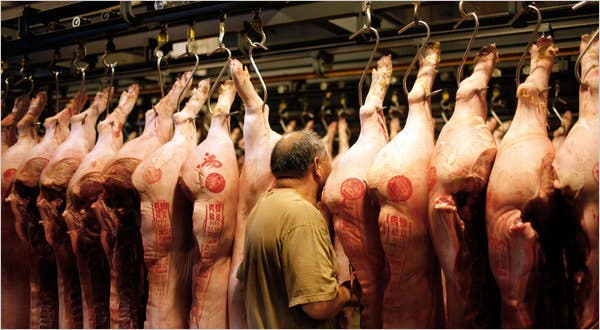The pace and scale of China’s economic transformation have no historical precedent. In 1979, China initiated a series of reforms which set the country in economic high gear producing some of the most fundamental changes ever to occur in any country. China’s annual average GDP per capita growth in the last ten year period was 9.9 percent, compounding to a total increase in GDP per capita of 158 percent. This astonishing growth has however also fueled some of the most profound social and environmental shifts. What’s funny about China’s economic growth is that it can be correlated to an unlikely proxy: pigs.
According to The Economist, the Chinese are fattening up on their favorite vegetable: pork. This may sound like a cruel joke, but you might first want to consider that Chinese pigs are gobbling up nearly half the world’s feed crops. Already in 2010 China’s soy imports accounted for more than 50% of the total global soy market, and grain imports a skyrocketing. The US Grains Council, a trade body, predicts that by 2022 China will need to import 19m-32m tonnes of corn, almost a third of the world’s entire trade in corn today.
You may have heard about how China is buying real estate all over the world. Some 5m hectares have been bought in developing countries alone, according to Sustainable Development, a Canadian think-tank. Of course, this land is used to raise buildings, factories, other business or just to control the market, but much of it will also be used as farm land. Shuanghui, China’s largest pork producer, bought Smithfield Foods, an American firm, in 2013 and with it acquired huge stretches of Missouri and Texas. So, what? The rest of world eats a lot of pork too. Yes, but the average Chinese eats 39kg of pork per year – more than Americans, who granted prefer beef. To put things into perspective, that’s five times more per person than they ate in 1979. In 1949, most people in China got only 3% of their annual calorific intake from meat.
The Chinese are in love with pork meat, which is deeply linked with prosperity. In Mandarin the word for “meat” and “pork” are the same. The character for “family” is a pig under a roof. But, historically, the Chinese ate little pork because it wasn’t plentiful. When China grows, so do its pigs. In fact, it’s so deeply tied to its economy that in 2007 when 45 million pigs were killed by “blue ear pig disease”, not only did pork prices skyrocket, but all other products as well. The the annual rate of increase of the consumer price index – an index that gauges consumption – is also called the “consumer pig index”. In fact, the government set up the world’s first pork reserve! Millions of pigs are owned by the government – some frozen, others alive – and released on the market when pigs become too expensive.
The Chinese’s insatiable appetite for pork, however, comes at a hefty price. For each kg of pork meat, growers need to supply 6 kg of feed, typically processed soy or corn. As mentioned earlier, though, more than 50% of the world’s soy goes to China’s pigs. Argentina exports almost all of its soybean to China, and in order to grow more it has cut down thousands of hectares of forest.
Besides the displacement of CO2 sucking trees, pigs themselves contribute significantly to global warming. Like all animals, pigs release methane and nitrous oxide. Methane is a greenhouse gas which is 300 times more potent than CO2 at trapping heat. Greenhouse-gas emissions from Chinese agriculture increased by 35% between 1994 and 2005, and according to Tony Weis of the University of Western Ontario, Canada, livestock production is responsible for almost a fifth of emissions produced by human activity.
Both a symbol of prosperity, and a menace, the pig is yet to have its final say in Chinese life.










